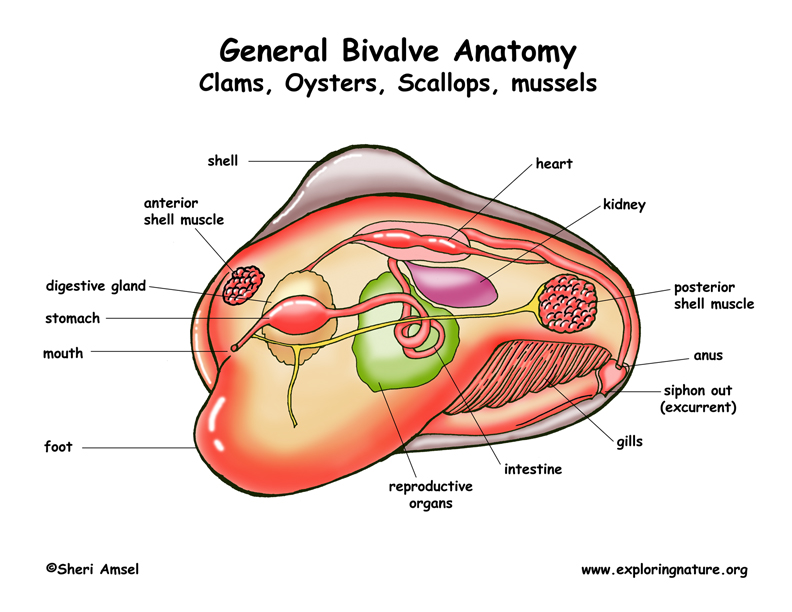

The Bivalves
Bivalves include clams, oytsters, mussels and scallops.
Habitat: They are found in both salt (marine) and freshwater habitats.
Physical Traits: They have two shells connected by a hinge – called the ligament, and kept closed by powerful muscles. The shells can open and close when needed, but are usually held closed by powerful muscles to protect them from predators. All use their muscular foot to meet their different lifestyle needs. Clams burrow into the sandy bottom. Scallops burrow or swim freely, using their shell to “clap” water propelling them as needed. Mussels use their foot to anchor to rocks and other objects. They have gills that are bathed with fresh water (and oxygen) through posterior siphons. They have no head, but a diffuse nerve network made up of three nerve centers (or ganglia) distributed around their visceral mass.
Diet: Unlike many mollusks that feed using a rasping tongue, called a radula, bivalves feed by filtering food particles from the water. They do this by siphoning water over the gills which traps it and propels it toward the mouth.
___________________________________________________________________________________________
They are found in temperate oceans throughout the world in both salt (marine) and freshwater habitats.
They have two shells connected by a hinge – called the ligament and kept closed by powerful muscles. The shells can open and close when needed, but are usually held closed by powerful muscles to protect them from predators. All use their muscular foot to meet their different lifestyle needs. They have no head, but a diffuse nerve network made up of three nerve centers (or ganglia) distributed around their visceral mass.
Clams burrow into the sandy bottom. Scallops burrow or swim freely, using their shell to “clap” water propelling them as needed. Mussels use their foot to anchor to rocks and other objects. They have gills that are bathed with fresh water (and oxygen) through posterior siphons.
Unlike many mollusks that feed using a rasping tongue, called a radula, bivalves feed by filtering food particles from the water. They do this by siphoning water over the gills which traps it and propels it toward the mouth.
They are found on the Pacific coast of North America, from Alaska to Mexico living on rocks and pier pilings in tide pools that are sometimes wet and sometimes dry (middle intertidal zone).
They are blackish-blue with darker edges. They have growth rings and white blotches. They are about 5 inches long (130 mm).
They gather in huge beds, sometimes many layers thick. They attach to surfaces with fine fiber threads from their muscular “foot” that send out a glue that sticks them fast to where they are. Big waves can tear off mussels and star fish feed on them.
They open their shells just a bit at high tide to feed. They feed by pulling seawater through their shells and filtering out plankton in their gills to feed on.
Males and females send out “broadcast” sperm or eggs into the water where fertilization occurs.
When you research information you must cite the reference. Citing for websites is different from citing from books, magazines and periodicals. The style of citing shown here is from the MLA Style Citations (Modern Language Association).
When citing a WEBSITE the general format is as follows.
Author Last Name, First Name(s). "Title: Subtitle of Part of Web Page, if appropriate." Title: Subtitle: Section of Page if appropriate. Sponsoring/Publishing Agency, If Given. Additional significant descriptive information. Date of Electronic Publication or other Date, such as Last Updated. Day Month Year of access < URL >.
Amsel, Sheri. "Class - Bivalvia (Clams, Oysters, Mussels and Scallops)" Exploring Nature Educational Resource ©2005-2024. December 13, 2024
< http://www.exploringnature.org/db/view/Class-Bivalvia-Clams-Oysters-Mussels-and-Scallops >



